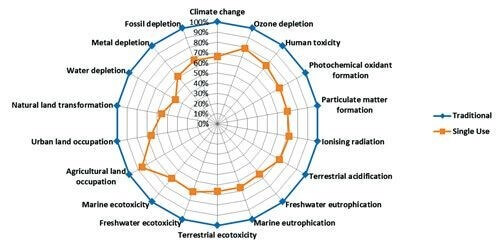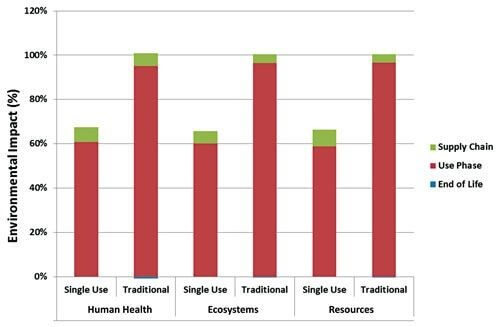Bioprocessing – The Environmental Impacts of Single-Use vs Stainless Steel Bioreactors
In the environmental movement, it is well known that single-use plastics for consumer products are an obvious negative. However, when it comes to bioreactors and bioprocessing, single-use plastics can be significantly advantageous compared to the traditional bioreactor. In addition to providing pharmaceutical companies with flexible, scalable solutions, single-use bioprocessing equipment has proven to be a much more environmentally friendly option than reusable stainless steel bioreactors. This holds true for scales ranging from small pilot facilities to 20,000 L bioreactor skids.
This article will focus on:
- Reviewing literature on the environmental impacts of bioprocessing
- Examine wastewater streams as an example of the environmental impact of clean-in-place/steam-in-place (CIP/SIP)
- Discuss process intensification as a means of reducing the overall environmental impact of bioprocessing
Environmental Impacts of Bioprocessing
To look at the impacts of bioprocessing, two studies will be focused on that demonstrate how single-use bioreactors are significantly more environmentally friendly than stainless steel reactors. These studies make the following assumptions:
- CIP/SIP between each batch requires a standard amount of energy and supporting equipment
- Single-use bioreactors are compared to multiuse stainless steel bioreactors
- Single-use components arrive at the pharmaceutical manufacturing site pre-sterilized by irradiation
- Single-use components are disposed of via hazardous waste incineration
First Case Study: Steel Bioreactors Are More Harmful to Humans and Ecosystems
Purpose & Design: In 2014 a study by GE Healthcare was carried out and published in BioPharm International which examined the production monoclonal antibodies to compare single-use and stainless steel bioprocessing technologies. The writers split pharmaceutical production into 14-unit operations along with an additional support unit encompassing all operations required for CIP/SIP. The cost of energy was decided based on the equipment has a 10-year life span, with 25% of equipment then reused, 67% recycled, and the remaining 8% landfilled.
Results & Analysis: The authors examined the full process trains at 100 L, 500 L, and 2,000 L scales for a 10-batch campaign. There were 18 categories used to assess the environmental impact including human toxicity along with depletion of water, metal, ozone, and fossil. Single-use bioreactors proved to be more advantageous than multiuse bioreactors in each of the categories that were demonstrated. Please see figures below that show the impacts of single-use vs. multiuse bioprocessing.

Figure 1: 18 categories were used to assess environmental impacts of single-use vs. multiuse bioprocessing. Impact of multiuse reactors are normalized to 100%.
This study compared the environmental effect on human health, ecosystems, and resources at various lifecycle phases: supply chain refers to the materials and manufacturing of process equipment (including consumables); use phase refers to the impacts of production, including CIP/SIP; and end-of-life refers to the disposal, reuse, or recycling of equipment. The below figure 2 shows that about 90% of the environmental impact of a bioprocess results from the lifetime usage.

Figure 2: Comparing environmental impacts at various lifecycle stages. Lifetime operation, including CIP/SIP, accounts for 90% of the total environmental cost of bioprocessing.
Key Outcomes: The study demonstrated that single-use equipment is significantly more environmentally friendly when compared to the traditional stainless-steel bioprocessing equipment. The biggest savings are in the energy costs of lifetime usage: with energy savings attributed to removing the processes necessary for CIP/SIP.
Study 2: CIP/SIP Accounts for Over Half of the Energy Consumption of Stainless Steel Skids
Purpose & Design: BioProcess International studied closely the energy costs of single use vs. multiuse bioprocessing systems. The energy calculations were based off the following factors:
- Single-use plastics are assumed to be made entirely of polypropylene
- Stainless-steel bioreactors have a lifetime of 600 production batches, but the required liquid and air filters must be regularly replaced
- Single use bio containers are housed in stainless steel totes without vent filters
- Single use capsule filters inside stainless steel housings are used instead of standard liquid and exhaust gas filters
- Single-use membrane absorber capsules are used instead of standard chromatography columns and resins
Results & Analysis: The table below shows a summary of energy calculations for single use bioprocess systems when compared to the multiuse stainless steel systems. Materials production refers to the energy cost of manufacturing the components for the two solutions; sterilization refers to SIP between batches for stainless steel systems or pre-sterilizing components by irradiation for single-use systems; and cleaning refers to CIP for reusable skids, most often using a combination of pyrogen-free distilled water, sodium hydroxide, and phosphoric acid in standard, pre-determined quantities.
|
Single-use energy consumption (Megajoules) |
Multiuse stainless steel energy consumption (Megajoules) |
|
|
Materials production |
4,100 |
1,100 |
|
Sterilization |
30 |
2,000 |
|
Cleaning |
0 |
4,900 |
|
Total |
4,130 |
8,000 |
Although manufacturing with stainless steel bioprocess systems is significantly more energy intensive than the plastic systems, the disposable plastic components must be replaced for each batch. This means that the cumulative energy expenditure to produce single use components is almost 4 times higher than the energy expenditure when manufacturing the multiuse components. Although single use components are often disposed of by incineration, this is not nearly enough recovery to overcome the large difference in energy costs.
SIP calculations assumed a steam generator output of 500 kW/h, and 100 L of water necessary to provide 30 minutes of steam at 130oC, with SIP between each batch. When compared to the single-use components which are irradiated by the manufacturer and then disposed of after use. This means that sterilising multiuse skids in between batches is over 6x more energy intensive than the single-use components being sterilised before use.
The biggest expenditure of energy in the traditional bioreactor is when producing the pyrogen-free distilled water that is necessary for cleaning. The 4,900 MJ which this study determined to be necessary for cleaning multiuse systems lies in sharp contrast to 0 MJ required for single-use components, which do not need to be cleaned.
Key Outcomes: Single use bioreactors are notably less energy intensive than the multiuse bioreactors over the lifetime of use. CIP/SIP accounts for the majority of the energy requirements that traditional bioreactors need which results in the elimination of inline cleaning and sterilisation in the single use systems is an extreme environmental advantage.
Example: Waste Streams Resulting From CIP/SIP
Waste streams are the result of cleaning reusable components and must be processed as they leave pharmaceutical plants before being introduced into the sewer system. The concentrations of various trace metals and materials that can be toxic to organisms as well as looking at stream volumes and the expected dilution of the waste streams when mixed with other waste at the treatment plant.
Standard cleaning solutions for reusable stainless steel and plastic components include 1 M sodium hydroxide, 1 M phosphoric acid, pyrogen-free distilled water, buffers, cleaning agents, and steam. The sanitation solutions usually have diluted bleach, and wipe-down solutions are typically quaternary disinfectants. The solutions must be rinsed several times which creates chemical runoffs that need proper handling.
Regulatory drivers have moved the pharmaceutical facilities from chemical sanitation to steam sanitation in a bid to address the issues associated with chemical waste streams. Steam sanitation creates less chemical runoff and energy that is required to treat the waste streams. However, steam generation has a high energy cost which can offset the advantages.
Impact of CIP/SIP and the Role of Process Intensification as a Remedial Solution:
Through the studies cited and others, CIP/SIP have been shown to be the primary contributor to the environmental footprint of a pharmaceutical facility. The advantage conveyed by single use bioprocessing systems is that they are disposed of and replaced rather than cleaned and reused. There are higher manufacturing costs as the components need to continually be replaced but single use systems can achieve much lower environmental footprint by avoiding inline cleaning and sterilisation.
Even though they have environmental advantages, single use bioprocessing systems are not always feasible when it comes to scale or extreme operating conditions to fluid incompatibilities. Process intensification therefore provides a simple means by which to introduce significant energy savings into the plant.
Hybrid Systems Provide a Practical Yet Environmentally Conscious Design:
The hybrid systems consist of a combination of single use and multiuse skids and can offer a unique opportunity to reduce the environmental footprint without requiring a complete overhaul of the facility and process. This allows system designers to take advantage of skids with appropriate single-use solutions, while recognizing their limitations in other areas.
Skids Designed for Easy CIP/SIP Lead to Less Water and Steam:
Designing easy cleanable skids results in CIP/SIP procedures that require less water and fewer chemicals which results in less wastewater treatment, less steam generation and all-around lower energy cost. The skids that allow for in-line buffer dilution would mean smaller buffer holding tanks which results in less equipment to clean and sterilise and time savings from not needing to move various pieces around the facility. This in turn can lead to smaller facility sizes, which have lower HVAC costs.
Operator Training Means Producing Only Necessary Waste:
Offering expanded training to operators is as simple step in leaner processing and achieving process intensification. Overages are built into standard operating procedures, but overly cautious operators may want to add an extra rinse. Training operators closely on SOPs and the reason behind each step will prevent unnecessary rinsewater or buffer production – and reduce inventory to only what is strictly necessary. This is particularly useful given that refrigerant gases have a large environmental footprint.
Want to find out more?
If you are interested in learning more about bioprocessing, please contact a member of our sales team today, they will be happy to help.
Contact us Today! |
